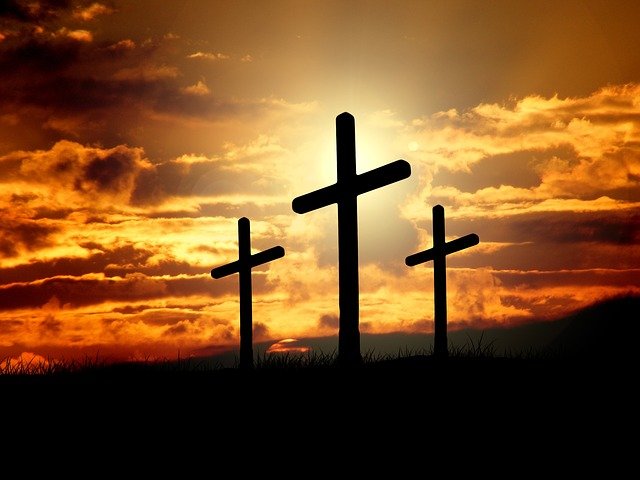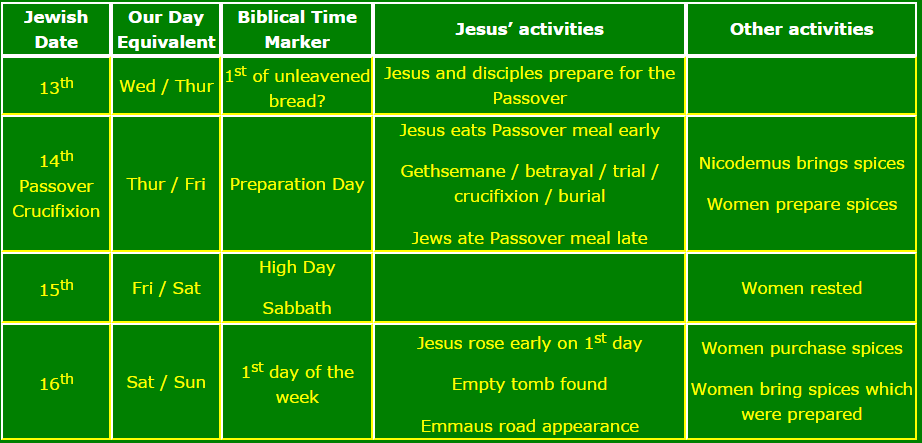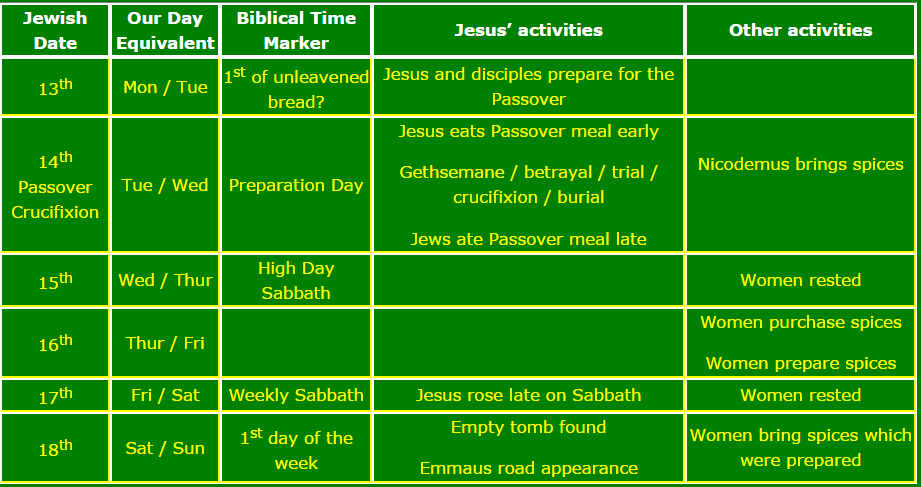
Let us start off by saying that it really does not matter on which day of the week Jesus was crucified, and for that matter on which day he rose from the dead. What really matters is THAT he died a literal death, and rose bodily from the dead.
The reason I write this article is because someone challenged my claim that the early church met on Sundays rather than Saturdays because Jesus rose on the 1st day of the week. That being said, there are many other scriptural reasons why most Christians no longer observe the Sabbath. Nevertheless I spent a lot of time and effort debating with him, so I decided to put up a new article on it. For me this is merely an academic issue.
If you like this kind of stuff keep reading. If not, there are lots of other topics on this website you might like.
Main Points
-
- Both a Friday and a Wednesday crucifixion can explain the timeline of crucifixion events.
- Jesus did not rise after 72 hours. He rose on the 3rd day.
- There were not two separate sabbaths during Jesus’ crucifixion. If there were two, they fell on the same day.
- The order of events fit better with the Friday crucifixion.
DOWNLOAD FREE CHAPTERS FROM OUR NEW BOOKS
Three Views
There are three major views regarding Jesus’ crucifixion. The most popular view is that He was crucified on a Friday. This is also my view which I will defend. Another view holds that He was crucified on a Wednesday. A fringe view holds to a Thursday crucifixion, which I will not discuss here.
Everyone agrees that Jesus was already risen by Sunday morning. To simplify the writing, I will refer to those who believe in a Friday crucifixion as Fridayfolk, and those who believe in a Wednesday crucifixion as Wednesdayrians.
The Jewish day
Note that the Jewish day was counted from sunset to sunset i.e. 6 pm to 6 pm as we understand it. The Jewish Sabbath started on Friday at 6pm and ended on Saturday at 6pm, while the 1st day of the week is from Saturday 6pm to Sunday 6pm. Also the Jews did not have names for their days as we do. Instead they numbered their days. So “the first day of the week” in Greek (mia ton sabbaton) would literally be translated “day one after the Sabbath”.
Those who hold to a Friday crucifixion believe that He actually rose early on the first day of the week (sometime between Saturday 6pm and Sunday 6am) – on the 3rd day. Those who hold to a Wednesday crucifixion believe that he rose sometime around 6 pm on Saturday – some say before 6 pm and some say after 6pm – after literally 3 days and 3 nights.
Timeline of events
The bible gives us enough information to determine a timeline of events that pertain to Jesus’ crucifixion and resurrection, as shown in the following tables. The first table shows the timeline of events according to the Friday crucifixion – Sunday resurrection view, while the second shows the events according to the Wednesday crucifixion – Saturday resurrection view. The Jewish dates are based on the Old Testament scriptures that outline when the Passover and the Feast of Unleavened Bread must take place (Ex 12; Lev 23; Num 28; Deut 16). Remember that each Jewish day starts at sunset. So for example, in the first table below, the 14th of Nisan (Abib) starts on Thursday 6pm and ends on Friday 6pm.
FRIDAY CRUCIFIXION – SUNDAY RESURRECTION

WEDNESDAY CRUCIFIXION – SATURDAY RESURRECTION

Differences
Both views can account for all the events detailed in the scriptures. What’s also interesting is that in 31AD Passover was on a Wednesday, whereas in 30AD it was a Friday. So both views can claim to fit with secular history. The major differences between the views are as follows:
- The Friday view believes Jesus rose on the 3rd day (inclusive reckoning) while the Wednesday view believes that He rose literally after 72 hours.
- The Wednesday view asserts that there were two separate Sabbaths during the week that Jesus died, while the Friday view maintains that both Sabbaths fell on the same day.
- Both views differ on the order in which women purchased and prepared spices to anoint Jesus’ body.
Interesting Scriptures
Before we discuss the differences above, there are a couple of points that need to be made. Fridayfolk believe that Jesus rose on the 1st day of the week. However, Wednesdayrians promptly point out that the Bible does not explicitly state that Jesus rose on Sunday. All it says is that Mary came to the tomb on the 1st day of the week and found it empty (See Matt 28, Mark 16, Luke 24, John 20). Jesus could have risen any time before that. They believe that he must have been in the grave for exactly 72 hours, so that would put his resurrection at Saturday 5pm. The empty tomb was only discovered the following day.
There is however one scripture that directly states the day of Jesus’ resurrection.
Mark 16
Mark 16:9
Now when He rose early on the first day of the week, He appeared first to Mary Magdalene,
Wednesdayrians point out that the Greek word for “He rose” (anastas) is in the perfect tense, meaning that it had already happened sometime earlier. So according to them, this scripture should be translated “Now when he was already risen on the first day of the week …”. It would be no different from saying, “Yesterday when Jesus was already risen, I watched a beautiful sunset”. Clearly that part about Jesus being risen is redundant. If he is appearing to Mary, clearly he is risen. What is the point in saying it if Mark did not intend to communicate the day of his resurrection?
What Wednesdayrians don’t realize is that this was a common style in the writing of Mark. There are numerous other scriptures that use the word “anastas” in the perfect tense – Mark 1:35; 2:14; 7:24; 10:1; 14:60. In Mark 2:14, Jesus told Levi to follow him, and Levi arose (anastas) and followed. Do you think the perfect tense of anastas should be translated, “And Levi, having already risen, followed him”? It doesn’t make sense. The context does not suggest that Levi had already risen sometime prior to Jesus calling him.
Mark 14
Look at another scripture. Mark 14:63 says that the high priest tore his clothes when he thought Jesus had committed blaspheme. The Greek word for tore “diarrexas” is in the perfect tense. Does this mean that when Jesus claimed to be the son of God, the high priest’s clothes were already torn? This was a common style used by Mark to write using the perfect tense. Mark 16:9 does not state that Jesus was already risen on the first day of the week, but that he actually rose on the 1st day of the week.
Nevertheless, others will say that Mark 16:9 doesn’t count, because it was part of the long ending of Mark that might not have been part of the original gospel of Mark. Some believe that Mark 16:9-20 was added later on by scribes. If you have an NIV bible, there will be a footnote by these verses explaining that some ancient manuscripts do not contain those verses. So I will make my case independently of Mark 16:9.
John 20
John 20:
17 Jesus said to her, “Do not cling to Me, for I have not yet ascended to My Father; but go to My brethren and say to them, ‘I am ascending to My Father and your Father, and to My God and your God.’”
27 Then He said to Thomas, “Reach your finger here, and look at My hands; and reach your hand here, and put it into My side. Do not be unbelieving, but believing.”
Another interesting scripture is John 20:17. This is after Jesus was risen and had appeared to Mary. He told her not to touch Him because he had not as yet ascended to the Father. Then he mentioned that He was going to the Father. Later on, he had no problem with Thomas touching his sides (John 20:27). Now I know that this scripture is subject to various interpretations, but it would seem that Jesus had ascended to His Father some time prior to his final ascension 40 days later.
Here is my question. If Jesus was already risen since 5pm the day before (more than 12 hours previously), why did he wait so long to ascend to the Father to do whatever he had to do? Was he waiting for the rapture? Again a natural reading would give the impression that Jesus had just risen. But again, since this scripture is such a difficult one to interpret, I will not base my view on this scripture alone.
Passover discrepancy?
I also need to resolve an apparent discrepancy between the synoptic gospels (Matthew, Mark and Luke) and John regarding the timing of the Passover relative to Jesus’ death. In John 19:31, Jesus was crucified on the Preparation Day for the Passover, that is the day before the Passover. Yet we see in Matthew 26:17 and Mark 14:12, Jesus alive and well celebrating the Passover with his disciples. So which is it? Note that both Fridayfolk and Wednesdayrians need to resolve this discrepancy, since it does not favor one or the other.
God’s instructions for the Passover and the Feast of Unleavened Bread can be found in Lev 23, Numbers 28 and Deut 16. There were differences among the Jews regarding the interpretation of what time the Passover meal was to be eaten, and when the 7 day feast was to begin and end. You would find that Leviticus 23 and Numbers 28 seem clear, but the Deuteronomy scripture messes things up. So the Jews were divided on this issue.
Each day entailed two sunsets. Was the Passover meal to be eaten just after sunset at the beginning of the day, or just before sunset at the end of the day? Immediately following the Passover was the Feast of Unleavened Bread. But the Passover meal was itself an unleavened meal. So when does the 7 day feast of unleavened bread begin – the day of the Passover, or the day after? Over time, the Passover and Feast of Unleavened were considered a single event rather than two separate events.
Different systems for observing the Passover
The Sadducees and the aristocrats ate the Passover meal at the beginning of the 14th, and considered the 14th to be the 1st day of unleavened bread (System A ).
The Pharisees and the majority of common folk ate the Passover meal at the end of the 14th, and considered the 15th as the 1st day of unleavened bread (System B).
Jesus ate the Passover at the beginning of the day (just after sunset at the beginning of the 14th) according to System A. See Matt 26:19, 20; Mark 14:16, 17; and Luke 22:13-15. Later that night he was betrayed, and by 3pm (later the same day), he was crucified. The majority of the Jews were preparing for a Passover meal later that same day according to System B. See Matt 27:62; Mark 15:42; Luke 23:54; John 19:14, 31.
Another difficulty
Another difficulty is that the day before Jesus’ crucifixion (13th of Nisan) was called the 1st day of unleavened bread (Matt 26:17; Mark 14:12). According to the two diagrams above, the 1st day of unleavened bread should technically be the 14th (System A) or the 15th (System B). Note again that both Fridayfolk and Wednesdayrians must deal with this difficulty – it does not favor either position over the other. Here are two possible explanations:
- It could be that some of the Jews considered the 13th to be the 1st day of unleavened bread because that was the day the preparations would have begun according to System A.
- Another possible explanation is the effect of Hellenization – the influence of Greek culture that was prevalent at the time. The Jews spoke Koine Greek. And the Greeks counted their days from sunrise. So the preparations that occurred on the Jewish 13th (6am-6pm) as well as the Passover that was eaten on the Jewish 14th (around 6pm), both occurred on the same Greek day, and possibly this day was called the 1st day of unleavened bread.
Now let’s analyze the differences between the two views.
1. 3 days and nights or the 3rd day?
The gospels use various terms to delineate the length of time Jesus would be in the grave. Clearly all of these refer to the same time period.
- 3 days and 3 nights – Matthew 12:40
- In or within 3 days – Matt 26:61; 27:40; Mark 14:58; John 2:19-21
- After 3 days – Matt 27:63; Mark 8:31
- On the 3rd day – Matt 16:21; 17:23; 20:19; 27:64; Mark 9:31; 10:34; Luke 9:22; 18:33; 24:7, 21, 46
Matthew 12:40
For as Jonah was three days and three nights in the belly of the great fish, so will the Son of Man be three days and three nights in the heart of the earth.
Wednesdayrians give a lot of emphasis to Matt 12:40 where Jesus predicted that he would be in the “heart of the earth” for 3 days and 3 nights, just like Jonah. They insist that it was not enough that Jesus rose from the dead, but that He must have risen after 72 literal hours. According to them, the sign of his Messiahship was not in his resurrection, but the timing of his resurrection.
Different Interpretations
Here are three different interpretations of this verse – Matt 12:40.
1) 3 days and 3 nights mean 72 hours. Since we know that Jesus was buried before 6pm (before the new day began), he must have risen around 5 pm thereabout. Since he was already risen by Sunday morning, then he must have risen at 5pm on Saturday, which makes Wednesday the day in which he was crucified and buried.
2) 3 days and 3 nights mean 3 full days and 3 full nights, not necessarily 72 hours. So he was buried at 5pm on Wednesday and the 3 full days and nights would be Wednesday 6pm – Thursday 6am (night 1), Thursday 6am – Thursday 6pm (day 1), Thursday 6pm – Friday 6am (night 2), Friday 6am – Friday 6pm (day 2), Friday 6pm – Saturday 6am (night 3) and Saturday 6am – Saturday 6pm (day 3). So he must have risen sometime after 6pm on Saturday.
3) The 3 days and nights are not to be taken literally, but is simply an expression that meant on the 3rd day. When Jews counted their days (and years), they counted any part thereof as a whole – a method known as inclusive reckoning. So if Jesus was buried at 5 pm on Friday and rose just before 6 am on Sunday, he would have been in the tomb for part of Friday (1st day), the whole of Saturday (2nd day) and part of Sunday (3rd day).
Literally 72 hours?
Note that the only interpretation that questions the Sunday (1st day of the week) resurrection is the one that believes that 3 days and nights mean 72 literal hours.
Wednesdayrians are very meticulous in counting the 3 days and 3 nights. But there are many reasons to believe that 3 days and 3 nights are not meant to be taken literally.
First of all if you count it, Jesus was technically in the grave for 3 nights and 3 days.
Also there are many scriptures that simply say that he will be dead for 3 days (omitting the 3 nights) – Matt 26:61; 27:40; 27:63; Mark 8:31; 14:58; John 2:19-21. If the 3 nights were really that critical, then they would not have left it out.
In other scriptures, Jesus merely stated that the only sign He would give is the sign of Jonah with no mention of days and nights – Matt 16:4; Luke 11:29-32. There is a strong argument that the actual sign Jesus gave was the person of Jonah, not the length of time he was in the whale’s belly. For a more detailed discussion on the sign of Jonah, check this site for some interesting reading.
Inclusive Reckoning
I believe that the expression 3 days or 3 days and 3 nights is not meant to be taken literally. The bible consistently speaks in a way that the people of the time could understand. For example, in Joshua 10:13, the bible reports that God made the sun stand still. With hindsight knowledge of astronomy, it is clear that what God really did was temporarily stop the rotation of the earth, so it appeared as though the sun stood still. The bible simply recorded that event in terms that people could understand, with no concern over scientific correctness.
Similarly, when Jesus said 3 days and 3 nights, He was simply using an expression that Jews commonly understood to mean on the 3rd day. He was not trying to be literal.
The Jews used a system of counting called inclusive reckoning. So if today is Sunday, for them the 3rd day would be Tuesday – Sunday, Monday Tuesday – 3 days or any part thereof. To a 21st century person, the 3rd day would be Wednesday. We simply cannot impose our 21st century understanding of an expression on the biblical text which was written to an audience in a completely different time and culture. It is more important to consider how the original audience would have understood Jesus’ words.
Other examples
There are quite a few scriptures that illustrate this. In 1 Kings 12:5, Rehoboam told Jeroboam to go and return after 3 days. The bible tells us that Jeroboam returned on the 3rd day, as Rehoboam had commanded (1 Kings 12:12). Also Esther told the Jews to fast for 3 days and nights (Esther 4:16). It goes on to say that on the 3rd day, Esther went to the king (Esther 5:1). When they heard 3 days or even 3 days and nights, they understood that to mean on the 3rd day.
Luke 24
So how do I know that it is not the other way around, that the 3rd day is not just an expression that means after 3 days and nights? Look at Luke 24:18-21.
18 Then the one whose name was Cleopas answered and said to Him, “Are You the only stranger in Jerusalem, and have You not known the things which happened there in these days?”
19 And He said to them, “What things?” So they said to Him, “The things concerning Jesus of Nazareth, who was a Prophet mighty in deed and word before God and all the people,
20 and how the chief priests and our rulers delivered Him to be condemned to death, and crucified Him.
21 But we were hoping that it was He who was going to redeem Israel. Indeed, besides all this, today is the third day since these things happened
Jesus appeared to some disciples after his resurrection on the road to Emmaus pretending to be a stranger. So Cleopas started to tell him about Jesus, that they crucified him, and TODAY IS THE 3RD DAY SINCE THESE THINGS HAPPENED. This is notable because this was on Sunday just before 6 pm. If Jesus was crucified on a Wednesday, then this would have been 96 hours later or 4 days and 4 nights. Cleopas’ reckoning makes no sense if Jesus was crucified on a Wednesday.
Wednesdayrian Response
So how do Wednesdayrians deal with Luke 24:21? They typically claim that Cleopas started counting his days from the time when ALL things were COMPLETED, i.e. from the time Pilate set the guards to watch over the tomb (which was the next day, Matt 27:65). So according to them, he started counting from Thursday, and hence Sunday afternoon would be “the 3rd day” since that.
This explanation is a desperate and dishonest attempt to explain away a clear scripture that contradicts their position. To understand what Cleopas meant by these things, you need to read vs 18-20. He referred to Jesus being delivered to the high priest and his crucifixion – that’s it. It is now the 3rd day since these things. He made no mention of the setting of the guard. It is unlikely that he even knew about the setting of any guard at that point. Luke 24:21 is a clear indicator that Sunday afternoon was still the 3rd day since Jesus was crucified. This only makes sense if Jesus was crucified on a Friday, and Cleopas was using inclusive reckoning.
2. Two Sabbaths?
Wednesdayrians have a dilemma because all four gospels state that the day after Jesus death was a Sabbath. Then the day after the Sabbath, the tomb was found empty. A natural reading would suggest that he died on Friday. It fits. To maintain belief in a Wednesday crucifixion, they assert that there were actually two Sabbaths during that week Jesus died.
According to their timeline, Passover was the Wednesday he died, the Thursday was the 1st day of unleavened bread (the 1st “Sabbath”), and Saturday was the regular weekly Sabbath (the 2nd rest day of the week). So they have Jesus dying before the 1st Sabbath, and the empty tomb discovered the day after the 2nd Sabbath.
According to the tables above, this view is plausible in that it can fit all the events. But the problem is that it requires a free Friday on which the Bible is totally silent. There is no hint of a day separating the two Sabbaths. It describes in detail the events that happened on his crucifixion day. It clearly mentions that the next day was a Sabbath. Then it jumps to the 1st day of the week to talk about his resurrection.
Mark 15:42 states that Jesus was crucified the day before the Sabbath, then Mark 16:1 opens with the day after the Sabbath. The most natural reading of the bible is that this is referring to the same Sabbath. But Wednesdayrians require us to believe that it is speaking of two different Sabbaths.
Feast days are never called Sabbath days
Another difficulty is that the Gospel writers never refer to a feast day as a Sabbath day. Yes, they were called Sabbaths in the Old Testament – High Sabbath, Great Day, or Annual Sabbath. But Matthew, Mark, Luke and John always called the feast days by their names. Even in John 19, John clearly calls the crucifixion day the Preparation Day for the Passover (John 19:14). But he also calls the day after the crucifixion a Sabbath.
In John 19:31, he noted that the following Sabbath was a High Day. Note that he did not say the follow day was a high Sabbath. There is a huge difference. The high day or high Sabbath was the rest day associated with the Jewish feasts (see John 7:37). If John had said, the next day was a high Sabbath, that would have suggested the rest day fell on some day other than Saturday. But he said, the next Sabbath was a high day. He is clearly saying that Saturday was a high day meaning that the annual Sabbath fell on Saturday, and thus coincided with the weekly Sabbath.
Wednesdayrians point out the Greek word for Sabbath in Matt 28:1 is plural – after the Sabbaths. Their explanation is that there were clearly two Sabbaths. But this does not rule out the possibility of both Sabbaths falling on the same day. According to the Friday view, the annual rest day (Sabbath) after the Passover fell on a Saturday and coincided with the weekly Sabbath. For some interesting discussions on plural Sabbaths in the Greek, check out these two sites.
Two other scriptures
Now let’s look at two other scriptures.
Luke 4:16
So He came to Nazareth, where He had been brought up. And as His custom was, He went into the synagogue on the Sabbath day (Sabbaton, plural), and stood up to read.Luke 6:1
Now it happened on the second Sabbath (Sabbatou, singular) after the first that He went through the grainfields. And His disciples plucked the heads of grain and ate them, rubbing them in their hands.
Luke 4:16 shows Jesus entering the synagogue on the Sabbath (Gr. Sabbaton – plural). In Luke 6:1, we see Jesus picking grain on the Sabbath (Gr. Sabbatou – singular). Clearly they are both referring to single days, yet in one case the plural Sabbaton is used while in the other, the singular Sabbatou.
There are two possible explanations for this. It could be that both words mean exactly the same thing and they are used interchangeably in scripture, in which case Matt 28:1 does not help the Wednesdayrians’ case. Or it is possible that the event in Luke 4:16 occurred on a weekly Sabbath which coincided with an annual Sabbath, hence the plural. If this is the case, then this supports the Fridayfolk’s view. If Wednesdayrians have another explanation for the plural Sabbath in Luke 4:16 (but singular in Luke 6:1), I’d love to hear it.
3. Events that occurred while Jesus was dead
Wednesdayrians claim that there were too many events to fit into the Friday crucifixion timeline. The most notable one they allude to is the purchasing of spices. They point to two scriptures.
Scriptures
Luke 23:56
Then they returned and prepared spices and fragrant oils. And they rested on the Sabbath according to the commandment.Luke 24:1
Now on the first day of the week, very early in the morning, they, and certain other women with them, came to the tomb bringing the spices which they had prepared.Mark 16:1-2
1 Now when the Sabbath was past, Mary Magdalene, Mary the mother of James, and Salome bought spices, that they might come and anoint Him.
2 Very early in the morning, on the first day of the week, they came to the tomb when the sun had risen.
Explanation
Luke 23:56 says they went home and prepared spices, then rested on the Sabbath. Mark 16:1 says when the Sabbath was over, they bought spices and came to anoint him. So how could they prepare the spices before the Sabbath, yet purchase the spices after the Sabbath? According to them, this only makes sense if there were two separate Sabbaths. They purchased the spices after the 1st Sabbath (Mark 16:1), which would be on Friday, then prepared the spices that same day (Luke 23:56), then rested on the weekly Sabbath. Then they brought the spices which were prepared the next day (Luke 24:1). They actually consider this to be definitive proof of two separate Sabbaths.
So their order of events is Mark 16:1 – Luke 23:56 – Luke 24:1; Mark 16:2. They have a time gap between Mark 16:1 and Mark 16:2, because the latter occurs on the 1st day of the week, while according to them, Mark 16:1 occurred two days earlier. Again a natural reading of these passages would not lead anyone to believe there was a time gap there. Usually time gaps are indicated by words like “now” (at the beginning of Mark 16:1). There is no such indicator in Mark 16:2 of a time gap.
Difficulties with the Wednesday view
Another difficult with their view is that Luke 23:56 is clearly part of the burial narrative, while Luke 24 and Mark 16 are clearly resurrection narratives. They have Mark 16:1 and Luke 23:56 both occurring 2 days after the crucifixion, but before the resurrection. Again this does not come from a natural reading of the scriptures. This is why the majority of Christians do not believe it.
Yet another difficulty is that if there was an entire Friday while Jesus was in the tomb, why didn’t Mary go and anoint his body then? On the day Jesus was buried, Nicodemus brought some spices to the burial site (John 19:39). The reason they could not anoint his body right there and then is because there was not sufficient time left in that day. They had to come back another time. If he was crucified on the Wednesday, and Thursday was a rest day, why didn’t Mary come back on Friday to anoint the body? The bible only has her visiting the tomb on Sunday morning, when his body would have already begun to decompose. Why didn’t she go on the Friday? That would have made so much more sense.
Did Mary visit the tomb twice?
Is it possible that Mary did go on Friday, then again on Sunday? The answer is highly unlikely. For one the Bible does not say so. Also if Mary had been there on the Friday, she would have known that Pilate had placed guards to look over the tomb. Yet in Mark 16:3 while they were on their way to the tomb on Sunday morning, they were wondering to themselves who would help them roll away the stone. If they knew there would be guards there, all they had to do was ask them.
Then in John 20:15, when Mary found the empty tomb and was weeping because she did not know where they had moved his body, again if she knew there were guards, she would have just looked for them to ask them where the body was. When Jesus started talking to her, she thought he was the gardener. If she knew there were guards, she would have expected a guard, not the gardener. Mary’s visit to the tomb on Sunday was her first visit there. This makes no sense if there was an entire Friday in which she could have and should have anointed his body. Either Mary is a neglectful person, or the Wednesdayrian view is wrong.
Friday Timeline
So how could all those events fit into the Friday crucifixion timeline? Very easy. Nicodemus brought spices to the tomb on the burial day (Friday afternoon). The women prepared spices that same day (Luke 23:56), but could not anoint the body because there was insufficient time left in the day. They rested the next day, which was the Sabbath. Then they realized that they did not have enough spices, so sometime between Saturday 6pm and Sunday 6am, they bought some more. Doesn’t that explain everything?
Further, there is no indication that Luke 23:56 and Mark 16:1 are even talking about the same women. Mark and Luke could have been describing two separate but related events. These verses do not pose a problem for Fridayfolk. They certainly do not prove that there were two separate Sabbaths.
Conclusion
The events detailed in the four gospels regarding Christ’s crucifixion, burial and resurrection can fit into a Wednesday crucifixion or Friday crucifixion scenario. But the Wednesday scenario requires a lot of reconstruction that does not come out of a natural reading of the scriptures. It also does not fit with Luke 24:21 and Mark 16:9. If someone just read the bible alone without the help of any commentary or code book, a Friday crucifixion fits best with what the Gospel writers reveal to us.
Wednesdayrians are too literal in their reading of Matt 12:40. They insist that Jesus needed to be in the tomb for 3 literal days and nights or 72 hours. But there are various other scriptures where Jesus gave the sign of Jonah without any mention of a time period.
The real sign that Jesus gave was not the length of time he would be in the tomb. Jonah the prophet was the sign. The reason the people of Nineveh were so quick to repent when Jonah preached to them is because they most likely knew what had happened to Jonah. It was his deliverance from the whale’s belly that proved to them that this prophet was really from God. This was the sign Jesus gave. He demonstrated his deity by bodily rising out of the grave. That’s how we know that He is God.
Get our books on Amazon






